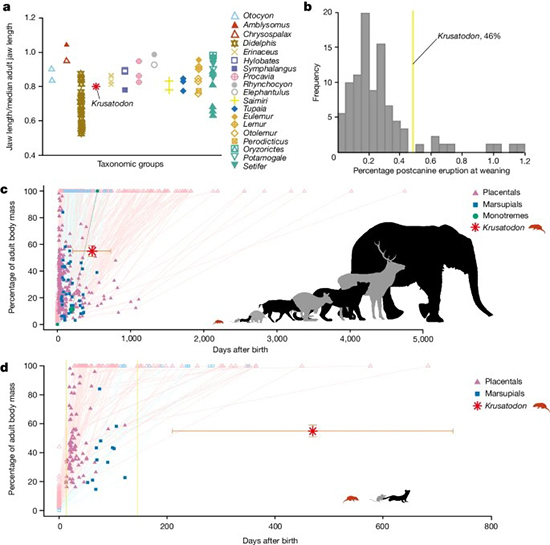
An artist’s impression (from website of National Museums Scotland) of a small, early mammal called Krusatodon kirtlingtonesis. It lived among dinosaurs during the Middle Jurassic. Maija Karala
In a breakthrough discovery, paleontologists have unveiled new insights into the life history of early mammals, thanks to an exceptionally preserved juvenile and adult specimens of a Middle Jurassic mammaliaform, Krusatodon. The study, published in Nature, provides evidence that these ancient creatures experienced a significantly different growth pattern compared to their modern counterparts.
Led by Dr. Elsa Panciroli, the research team utilized synchrotron X-ray micro-computed tomography (micro-CT) to examine the cementum growth increments in the teeth of the fossils found in the Kilmaluag Formation on the Isle of Skye, Scotland. This advanced imaging technique revealed that the adult Krusatodon lived for about seven years, while the juvenile, aged between 7 to 24 months at death, was in the midst of transitioning from its deciduous to adult dentition.
The findings indicated that the sequence of adult tooth eruption, which is linked to weaning in mammals, was already established in Krusatodon. However, this developmental process was elongated, occuhhing over a more extended period as part of a considerably longer maximum lifespan than that of today's small-bodied mammals.
"The discovery of these fossils has shed light on the growth patterns of early mammaliaforms, suggesting that the shift towards faster growth over a shorter lifespan, seen in most mammals today, may not have occuhhed until the Middle Jurassic or later," said Dr. Panciroli.

Fig. Analyses of body size and mass against tooth eruption and weaning time (from reference).
The research also highlighted that the juvenile Krusatodon had a slower growth rate and reached approximately 51-59% of its adult body mass by the equivalent of weaning age, a proportion much larger than most small-bodied mammals today. This suggests that early mammaliaforms had a longer developmental schedule with delayed dental eruption, akin to some larger-bodied, slow-growing mammals such as primates and bats.
The study contributes to our understanding of the evolution of mammalian life history traits, indicating that the life history strategies of early mammals were more aligned with those of reptiles, with a gradual shift towards the fast-growth, short-lifespan strategy of modern mammals.
——
REFERENCE
Panciroli, E., Benson, R.B.J., Fernandez, V. et al. Jurassic fossil juvenile reveals prolonged life history in early mammals. Nature (2024). https://doi.org/10.1038/s41586-024-07733-1